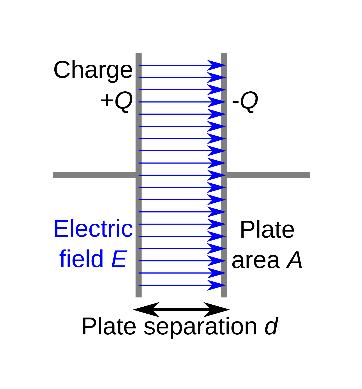Capacitors store Energy using the Electric Potential across two plates.
This is an example circuit with a capacitor
.png)
And a close up of just the capacitor.

The capacitor is composed of two plates with area
When the circuit is turned on by closing the switch electrons are allowed to flow through the wire. However, these electrons stop at the first plate and cannot cross the gap
Simultaneously, electrons leave the second plate and move towards the battery, leaving a positive charge in the second plate.
Note that because electrons enter the first plate and leave the second plate, the total charge in the capacitor remains the same. Capacitors do not store charge. Capacitors store electrical energy.
Because of the difference in charge between the plates:
- There is an Electric Field from the positive plate to the negative plate.
- The Electric Potential between the plates increases.
Even if we disconnect the battery or open the switch, the electrons will remain in the same configuration. The only difference to move the electrons is between the plates, and the electrons cannot cross the plates. Therefore, the capacitor can maintain and store its Electric Field and Potential Difference.
If we want to release the energy, we just connect the plates and electrons will flow once again.
The Capacitance is the ratio of the charge to the voltage (potential difference)